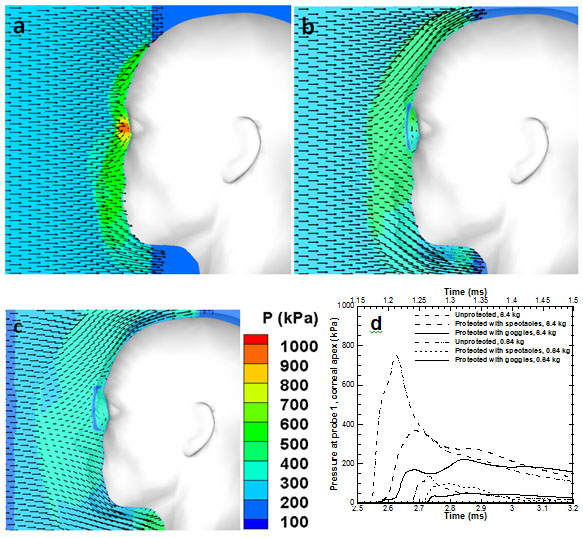


Posted June 30, 2015
Thao (Vicky) Nguyen, Ph.D., The Johns Hopkins University
 The incidence of blast injuries to the eye has risen dramatically in recent history due to increasing use of explosive weapons in military operations and terrorist attacks. In Operation Iraqi Freedom and Operation Enduring Freedom, blast from munitions and improvised explosive devices (IEDs) was responsible for 80% of ocular injuries. The exposed structures of the eye make up less than 1% of the face, yet eye injuries occur in up to 13% of combat casualties. Current protective eye equipment, which includes spectacles, goggles, and face shields made from transparent ballistic materials, are designed to protect mainly against high-velocity projectiles.
The incidence of blast injuries to the eye has risen dramatically in recent history due to increasing use of explosive weapons in military operations and terrorist attacks. In Operation Iraqi Freedom and Operation Enduring Freedom, blast from munitions and improvised explosive devices (IEDs) was responsible for 80% of ocular injuries. The exposed structures of the eye make up less than 1% of the face, yet eye injuries occur in up to 13% of combat casualties. Current protective eye equipment, which includes spectacles, goggles, and face shields made from transparent ballistic materials, are designed to protect mainly against high-velocity projectiles.
The high explosives used in modern warfare cause a "blast wave" of compressed gases that radiates outward, traveling at supersonic speeds through the human body. The blast wave moving through the body causes primary blast injury, which can tear eye tissue or carry debris that pierces the face/eye. When bombs detonate in an enclosed space, such as the interior of a vehicle or near a wall, the blast wave can bounce between surfaces, causing damage for a longer time. Blast waves can even bounce through gaps between the body and protective armor.
Because primary blast injuries to the eye rarely occur in isolation and are difficult to separate from injuries caused by blunt force trauma and penetrating fragments, little is known about their mechanisms, risk factors, physical manifestations, and injury criteria. Moreover, experiments in animal models are limited because the blast dynamics are strongly influenced by facial structures, which are inherently different in animal models than in humans.
Computational models provide a powerful alternative approach to study mechanisms of blast injury to the eye. Early computational models simplified the geometry of the face and the movement and energy of the blast wave. Dr. Nguyen, recipient of a fiscal year 2011 award from the Vision Research Program, developed a more robust model, including detailed anatomical and tissue features, and sophisticated mathematical techniques to model the movement of the blast wave and the transfer of energy when the blast wave hits the human face [1]. Her team collaborated with scientists from the Army Research Lab to develop a geometric model of the head representing an average 21-year-old male, and models of spectacles and goggles currently approved for military applications.
Dr. Nguyen simulated the impact of the blast wave with the face and showed that reflections from the protruding brow and nasal ridge focused the blast wave onto the eye. Thus for detonations near eye level, the blast wave inflicted the highest pressure loading nasally on the eye. The asymmetric distribution of blast pressure on the eye caused the eye to rotate in the orbit. This exerted large shear stresses at the interface between the sclera and orbital tissues, which can lead to tearing at the extra-ocular muscle attachments to the eye-wall. Propagation of the blast wave through the eye generated the largest stresses in the posterior eye-wall, near the macula and optic nerve head, which suggests the possibility of traumatic macular damage and glaucoma. However, the increase in intraocular pressure resulted in a low risk of rupture of the eye wall.
The model simulated the effectiveness of spectacles and goggles in reducing the blast pressure loading on the eye [2]. The simulations reproduced the conditions of field blast in experiments performed by collaborators at the Army Aberdeen Test Center measuring blast pressure at the eye location of an instrumented FOCUS Headform model [3]. The results of the simulations predicted the results of the blast experiments, which validate the modeling assumptions. Both spectacles and goggles dramatically reduced the peak pressure loading to the eye, but still allowed a small fraction of the blast wave to "underwash" through small gaps and reverberate between the surfaces of the goggles and the face. The goggles permitted a smaller amount of underwash, thus more effectively reducing the peak pressure loading compared to spectacles. The spectacles directed the flow along the lens and away from the eyes through the opening at the temples. However, the tighter fit of the goggles trapped the underwash in front of the eyes for a longer amount of time. As a result, the pressure loading on the eyes behind the goggles became higher than the pressure loading on the unprotected eyes and eyes behind the spectacles after 0.6 milliseconds post impact from the blast wave. Further study is needed to understand the injury implications of the persistent high-pressure loading of the underwash behind the goggles, which may be distinct from the shorter duration high-pressure loading of blast wave in the unprotected eye.
Dr. Nguyen is pursuing further developments of the computational model to more accurately describe the mechanical behavior and geometry of the tissues and eye. This will provide more accurate predictions of the distribution of stresses and strains in the internal ocular structures. The modeling approach can identify vulnerable locations in the eye to guide experimental studies of blast injuries. Moreover, the models provide an efficient numerical platform for the design of improved eye protection for primary blast injuries.

Simulation of the impact of the blast wave on the (a) unprotected eye, (b) eye protected by spectacles, and (c) the eye protected by goggles. The color contours indicate the blast pressure and the black arrows indicate the velocity vectors of the blast wave. The highest pressure loading developed at the eye in the unprotected cases because the brow and nasal protrusion act as reflectors focusing the blast wave on the eye. The spectacles and goggles deflected most of the blast wave from the eye, but allowed a small fraction of underwash through the small gaps with the face. (d) The pressure history at a point on the eye comparing the unprotected eye, eye protected by spectacles, and eye protected by goggles for blasts from two different charge masses. For both the small and larger masses, the maximum pressure decreased significantly with spectacles and goggles. However, the pressure loading on the eye protected by goggles decayed more slowly and became higher than the pressure loading on the unprotected eye and eye protected by spectacles after 0.6 ms after impact. Reproduced from "A computational model of blast loading on the eye," by R Bhardwaj, K Ziegler, JH Seo, KT Ramesh, and TD Nguyen. 2014. Biomechanics and Modeling Mechanobiology 13:123-140.
References:
[1] Bhardwaj R, Ziegler K, Seo JH, Ramesh KT, and Nguyen TD. 2014. A computational model of blast loading on the eye. Biomech Model Mechanobiol 13:123-140.
[2] Bailoor S, Bhardwaj R, and Nguyen TD. 2014. Effectiveness of eye armor during blast loading. Biomech Model Mechanobiol 13:123-140.
[3] Bentz V and Grimm G. 2013. Joint Live Fire (JLF) final report for assessment of ocular pressure as a result of blast for protected and unprotected eyes. Report number JLF-TR-13-01. U.S. Army Aberdeen Test Center, Aberdeen Proving Ground, Maryland.














